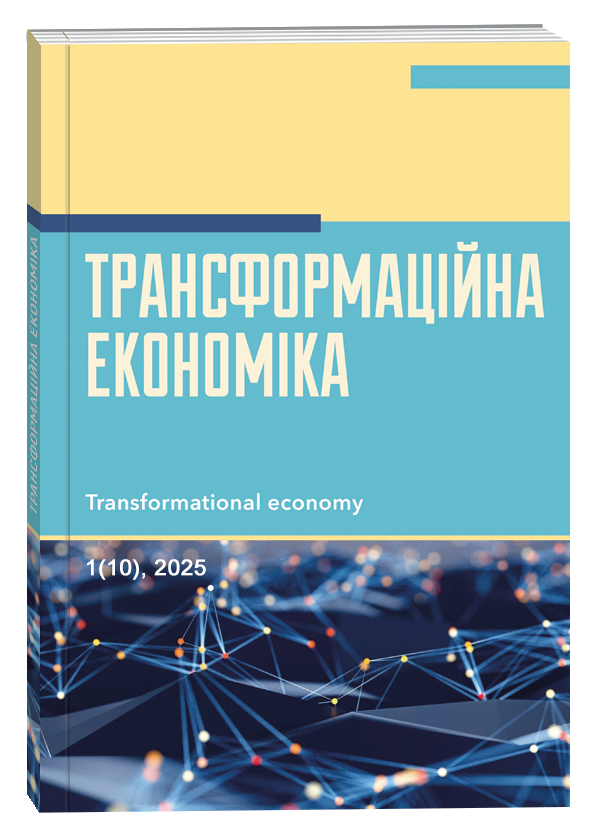INSTITUTIONS OF HIGHER EDUCATION IN THE MARKET ECONOMY AND TODAY'S CHALLENGES
Abstract
The article explores the evolving role and functioning of higher education institutions within the framework of a market economy, considering the pressures and expectations brought about by modern global challenges. It provides a comprehensive analysis of the transformational processes currently reshaping the higher education sector as a result of globalization, socio-economic realignments, rapid technological progress, and ongoing geopolitical developments. The author delves into how universities are adapting their operations and strategic priorities to meet the evolving demands of the labor market, intensified institutional competition, and the acceleration of digital transformation in education. A key focus of the article is the analysis of how universities are redefining their missions and structures to enhance their responsiveness, resilience, and innovation capacity in a dynamic environment. The study critically examines mechanisms through which institutions strive to maintain financial sustainability, ensure high standards of academic quality, and preserve their institutional autonomy while integrating into the global academic and research ecosystem. Special attention is given to the challenges and opportunities associated with internationalization, cross-border mobility of students and scholars, and the creation of transnational educational networks. The article also highlights the growing importance of strategic governance and adaptive leadership in higher education. In times of uncertainty and complexity, the ability of universities to plan long-term, respond flexibly to external shocks, and leverage emerging technologies becomes central to their success. The study proposes several strategic directions for improving institutional effectiveness, including the development of innovative educational models, public-private partnerships, and expanded stakeholder engagement. Overall, the article underscores the urgent need for systemic reform to ensure that higher education remains a driving force of socio-economic development and global competitiveness.
References
Гевко О., Голярдик Н. Дистанційне навчання в умовах війни: виклики та можливості для системи вищої освіти України. Збірник наукових праць Національної академії Державної прикордонної служби України. 2023. Т. 34(3). С. 57–72.
Будник О., Ніколаєску І. Цифрові технології у підготовці майбутніх педагогів: сучасні виклики дистанційної освіти. Viae Educationis. 2022. Т. 1, № 2. С. 69–80.
Ramskyi A. Digital transformation of communication strategies of higher education institutions of ukraine during the war. Scientific bulletin of International Association of scientists. Series: Economy, management, security, technologies. 2023. Vol. 2, no. 1. DOI: https://doi.org/10.56197/2786-5827/2023-2-1-7
Ніколаєнко С. М., Ніколаєнко М. С. Аграрна освіта в контексті реформування вищої школи України: сучасні виклики та тенденції в аграрному секторі. Вісник НАПН України. 2021. Т. 3, № 2. DOI: https://doi.org/10.37472/2707-305x-2021-3-2-17-3
Орєхова Т. В., Каленюк І. С., Унінець І. М. Сучасні виклики розвитку вищої освіти в умовах становлення розумної економіки. Бізнес-інформ. 2022. Vol. 8, no. 535. P. 67–74. DOI: https://doi.org/10.32983/2222-4459-2022-8-67-74
Akinwalere S. N., Ivanov V. Artificial Intelligence in Higher Education: Challenges and Opportunities. Border Crossing. 2022. Vol. 12, no. 1. P. 1–15. DOI: https://doi.org/10.33182/bc.v12i1.2015
Walter Y. Embracing the future of Artificial Intelligence in the classroom: the relevance of AI literacy, prompt engineering, and critical thinking in modern education. International Journal of Educational Technology in Higher Education. 2024. Vol. 21, no. 15. P. 1–29.
Goodhart C. A. E. Problems of monetary management: the UK experience. Macmillan Education UK, 1984. P. 91–121.
Hevko O., Holiardyk N. (2023). Dystantsiine navchannia v umovakh viiny: vyklyky ta mozhlyvosti dlia systemy vyshchoi osvity Ukrainy. Zbirnyk naukovykh prats Natsionalnoi akademii Derzhavnoi prykordonnoi sluzhby Ukrainy. T. 34(3). S. 57–72.
Budnyk O., Nikolaiesku I. (2022). Tsyfrovi tekhnolohii u pidhotovtsi maibutnikh pedahohiv: suchasni vyklyky dystantsiinoi osvity. Viae Educationis. T. 1, № 2. S. 69–80.
Ramskyi A. (2023). Digital transformation of communication strategies of higher education institutions of ukraine during the war. Scientific bulletin of International Association of scientists. Series: Economy, management, security, technologies. Vol. 2, no. 1. DOI: https://doi.org/10.56197/2786-5827/2023-2-1-7
Nikolaienko S. M., Nikolaienko M. S. (2021). Ahrarna osvita v konteksti reformuvannia vyshchoi shkoly Ukrainy: suchasni vyklyky ta tendentsii v ahrarnomu sektori. Visnyk NAPN Ukrainy. T. 3, № 2. DOI: https://doi.org/10.37472/2707-305x-2021-3-2-17-3
Oriekhova T. V., Kaleniuk I. S., Uninets I. M. (2022). Suchasni vyklyky rozvytku vyshchoi osvity v umovakh stanovlennia rozumnoi ekonomiky. Biznes-inform. Vol. 8, no. 535. P. 67–74. DOI: https://doi.org/10.32983/2222-4459-2022-8-67-74
Akinwalere S. N., Ivanov V. (2022). Artificial Intelligence in Higher Education: Challenges and Opportunities. Border Crossing. Vol. 12, no. 1. P. 1–15. DOI: https://doi.org/10.33182/bc.v12i1.2015
Walter Y. (2024). Embracing the future of Artificial Intelligence in the classroom: the relevance of AI literacy, prompt engineering, and critical thinking in modern education. International Journal of Educational Technology in Higher Education. Vol. 21, no. 15. P. 1–29.
Goodhart C. A. E. (1984). Problems of monetary management: the UK experience. Macmillan Education UK, P. 91–121.


